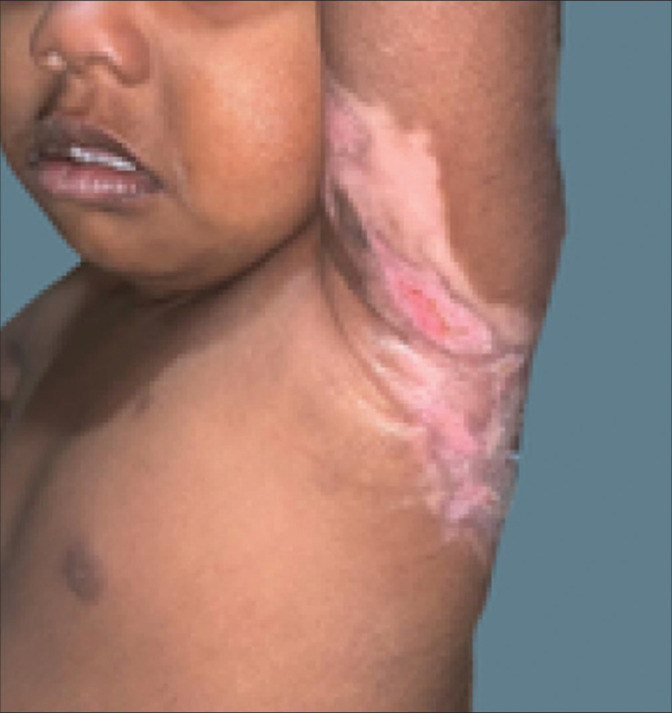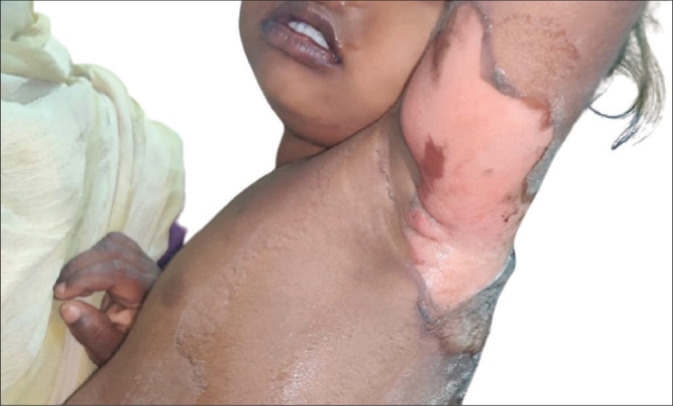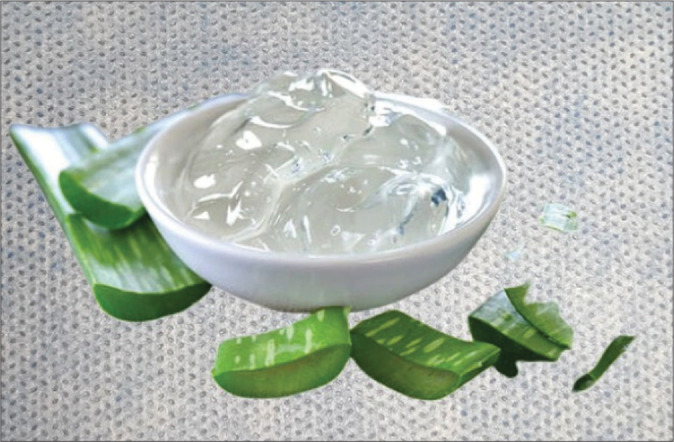Abstract
Aloe vera is a cactus plant that thrives in warm areas. Since ancient times, it has been used to treat acute wounds. However, the efficacy of aloe vera for burns and split-thickness skin graft (STSG) donor sites is inconclusive. In this study, we have applied pure aloe vera gel extract as an adjunct to dressing second-degree (superficial) burn wounds and assessed the time for complete epithelialization. The time taken for complete epithelialization of the wound was 11 days when compared to the normal (evidence-based) time of 14 days.
Keywords: Aloe gel extract, Aloe vera, Burns wounds, Superficial second degree burns
INTRODUCTION
Aloe vera is a cactus plant that thrives in warm areas. Since ancient times, it has been used to treat acute wounds.1 Numerous medicinal products are made from its mucilaginous tissue, called aloe vera gel, which is located in the center of the aloe vera leaf. Aloe vera is one of the best healing plants that has been used widely in the traditional herbal medicine since many years ago. This plant has previously been claimed to have immunological modulatory, anti-infectious, antiprotozoal, ultraviolet protecting, and wound- and burn-healing qualities.2-9
Because the skin is the largest organ in the human body and serves as a barrier to the body’s interior environment, major injury to it could pose a number of challenges to its existence. The epidermis and dermis are two layers of skin that cover the subcutaneous adipose tissue. Epidermis mainly comprises keratinocyte layers in which some other types of cells have spread, including melanocytes and Langerhans cells. Scar massage with emollients like aloe vera gel is a well-known method of scar management. In this case series, we examined the effect of aloe vera on cutaneous wound healing.
CASE REPORT
This study was conducted in the Department of Plastic surgery in a Tertiary care center in South India. Departmental ethical clearance and consent from the subject was obtained. In this study, we have applied pure aloe vera gel extract (commercially available preparation) as an adjunct to dressing second-degree (superficial) burn wounds and assessed the time for complete epithelialization [Figures 1-3]. The dressing of the wound was changed on every third day, and the wound was assessed by multiple independent residents who were kept blind about the aloe vera.
Figure 1:

Burns wound pre-application.
Figure 3:

Burns wound post-application.
Figure 2:

Pure aloe gel extract used.
Results
The time taken for complete epithelialization of the wound was 11 days when compared to the normal (evidence- based) time of 14 days.
DISCUSSION
Aloe vera is a Liliaceae plant that thrives in hot and arid climates. The mucilage tissue found in the heart of the leaves of this plant, commonly known as aloe gel, is used in a variety of cosmetics and medical uses. For the first time, the Egyptians employed the aloe vera plant to cure wounds, burns, and infections. Following them, Greeks, Spaniards, and Africans employed the aloe vera plant in a variety of ways for a variety of purposes. Aloe vera has a hot and dry humor, according to Iranian traditional medicine, and its extract is used for medical purposes.10,11
Vitamins, enzymes, minerals, carbohydrates, lignin, saponins, salicylic acids, and amino acids are among the 75 potentially active elements in aloe vera. Its pain and inflammation-relieving enzymes, carboxypeptidase, and bradykinesia, hydrolyze prostaglandins and bradykinins. Mannose-6-phosphate is a polysaccharide that promotes epithelialization and tissue remodeling, as well as fibroblast proliferation, collagen deposition, and wound healing. Another polysaccharide, acemannan, is a white blood cell activator that aids in the wound healing process. The glucomannan stimulates the activity and proliferation of fibroblasts, which improves collagen formation and secretion. Aloe vera mucilage not only increases the amount of collagen on the wound site, but also it improves the transversal connections between these bands, which promotes wound healing.2-6
Existing research suggests that aloe vera, in a number of dose forms, can help minimize the time it takes for first- and second-degree burns to heal, as well as boost the rate of healing success and epithelialization. In a guinea pig investigation, the enhancement of burn wound healing was demonstrated.9 The aloe vera gel extract allowed for speedier burn healing and rebuilt the vascularity of burn tissues, according to the study. In a study carried out by Maenthaisong et al.,2 it was demonstrated that aloe vera products are safe for topical use; no withdrawal or serious adverse reaction were; only irritation, itching, discomfort, and minimal transient pain were reported which are also common signs and symptoms in burns Burusapat et al.1 conducted a double-blind, randomized, controlled trial and systematic review on topical aloe vera gel for accelerated wound healing of split-thickness skin graft (STSG) donor sites and concluded that topical aloe vera gel significantly demonstrated accelerated STSG donor site healing but did not show significant pain relief; also aloe vera topical application was found to be ineffective in preventing radiation-induced damage. Another study conducted by Oryan et al.11 on Topical Application of Aloe vera Accelerated Wound Healing, Modeling, and Remodeling (experimental study on rats) concluded that topical application of Aloe vera improved the biochemical, morphological, and biomechanical characteristics of the healing cutaneous wounds; Aloe vera reduced inflammation, enhanced wound contraction and epithelialization, reduced scar tissue size, and improved scar tissue alignment and organization. In a study by Schmidt et al.,12 it was found that, when compared to an otherwise equivalent regimen that did not include aloe vera, the use of aloe vera dermal wound gel was associated with a considerable delay in wound healing. But in our study aloe vera gel was found to accelerate the healing process.
Limitation of the study
Since this is a single case report, a definite conclusion cannot be made. Large randomized controlled trials with systematic review needs to be conducted to confirm the efficacy of topical application of aloe vera gel on superficial partial-thickness burns.
CONCLUSION
The use of topical Aloe vera gel expedited the healing and epithelialization of second-degree burns. There was no noticeable pain alleviation or relaxing impact.
Funding Statement
Financial support and sponsorship
Nil.
Footnotes
How to cite this article: Reddy KS, Chittoria RK, Kerakada N, Thomas N, Srinath R, Indushekar TC, et al. Role of topical application of aloe vera for accelerated wound healing of cutaneous burns wound: A case report. J Cutan Aesthet Surg. 2024;17:246-8. doi: 10.4103/JCAS.JCAS_8_22
Authors’ contributions
All the authors contributed to the research study. K. SriHarsha Reddy: Concepts, Design, Definition of intellectual content, Literature search, Manuscript preparation, Manuscript Editing, and Manuscript review. Ravi Kumar Chittoria: Concepts, Design, Definition of intellectual content, Literature search, Manuscript preparation, Manuscript Editing, and Manuscript review. Nishad Kerakada: Concepts, Design, Definition of intellectual content, Literature search, Manuscript preparation, Manuscript Editing, and Manuscript review. Neljo Thomas: Concepts, Design, Definition of intellectual content, Literature search, Manuscript preparation, Manuscript Editing, and Manuscript review, R. Srinath: Concepts, Design, Definition of intellectual content, Literature search, Manuscript preparation, Manuscript Editing, and Manuscript review, T.C. Indushekar: Concepts, Design, Definition of intellectual content, Literature search, Manuscript preparation, Manuscript Editing, and Manuscript review, V.S. Sriram: Concepts, Design, Definition of intellectual content, Literature search, Manuscript preparation, Manuscript Editing, and Manuscript review.
Declaration of patient consent
The authors certify that they have obtained all appropriate patient consent forms. In the form the patient(s) has/have given his/her/their consent for his/her/their images and other clinical information to be reported in the journal. The patients understand that their names and initials will not be published and due efforts will be made to conceal their identity, but anonymity cannot be guaranteed.
Conflicts of interest
There are no conflicts of interest.
References
- 1.Burusapat C, Supawan M, Pruksapong C, Pitiseree A, Suwantemee C. Topical Aloe Vera gel for accelerated wound healing of split-thickness skin graft donor sites: A double-blind, randomized, controlled trial and systematic review. Plast Reconstr Surg. 2018;142:217–26. doi: 10.1097/PRS.0000000000004515. [DOI] [PubMed] [Google Scholar]
- 2.Maenthaisong R, Chaiyakunapruk N, Niruntraporn S, Kongkaew C. The efficacy of aloe vera used for burn wound healing: A systematic review. Burns. 2007;33:713–8. doi: 10.1016/j.burns.2006.10.384. [DOI] [PubMed] [Google Scholar]
- 3.Jia Y, Zhao G, Jia J. Preliminary evaluation: The effects of aloe ferox miller and aloe arborescens miller on wound healing. J Ethnopharmacol. 2008;120:181–9. doi: 10.1016/j.jep.2008.08.008. [DOI] [PubMed] [Google Scholar]
- 4.Tai-Nin Chow J, Williamson DA, Yates KM, Goux WJ. Chemical characterization of the immunomodulating polysaccharide of aloe vera L. Carbohydr Res. 2005;340:1131–42. doi: 10.1016/j.carres.2005.02.016. [DOI] [PubMed] [Google Scholar]
- 5.Vijayalakshmi D, Dhandapani R, Jayaveni S, Jithendra PS, Rose C, Mandal AB. In vitro anti inflammatory activity of aloe vera by down regulation of MMP-9 in peripheral blood mononuclear cells. J Ethnopharmacol. 2012;141:542–6. doi: 10.1016/j.jep.2012.02.040. [DOI] [PubMed] [Google Scholar]
- 6.Zhang L, Tizard IR. Activation of a mouse macrophage cell line by acemannan: The major carbohydrate fraction from aloe vera gel. Immunopharmacology. 1996;35:119–28. doi: 10.1016/S0162-3109(96)00135-X. [DOI] [PubMed] [Google Scholar]
- 7.Im SA, Oh ST, Song S, Kim MR, Kim DS, Woo SS, et al. Identification of optimal molecular size of modified aloe polysaccharides with maximum immunomodulatory activity. Int Immunopharmacol. 2005;5:271–9. doi: 10.1016/j.intimp.2004.09.031. [DOI] [PubMed] [Google Scholar]
- 8.Chithra P, Sajithlal GB, Chandrakasan G. Influence of aloe vera on collagen turnover in healing of dermal wounds in rats. Indian J Exp Biol. 1998;36:896–901. [PubMed] [Google Scholar]
- 9.Barcroft A, Myskja A, Reynolds T. New York, NY: BAAM; 2003. Aloe Vera: Nature's Silent Healer. [Google Scholar]
- 10.Reynolds T. The Genus Aloe. Boca Raton, FL: CRC press; 2004. Aloes; p. xvii + 386. pp. Manitto P. J Natural Products 2005;68:153. [Google Scholar]
- 11.Oryan A, Mohammadalipour A, Moshiri A, Tabandeh MR. Topical application of aloe vera accelerated wound healing, modeling, and remodeling: An experimental study. Ann Plast Surg. 2016;77:37–46. doi: 10.1097/SAP.0000000000000239. [DOI] [PubMed] [Google Scholar]
- 12.Schmidt JM, Greenspoon JS. Aloe vera dermal wound gel is associated with a delay in wound healing. Obstet Gynecol. 1991;78:115–7. [PubMed] [Google Scholar]


